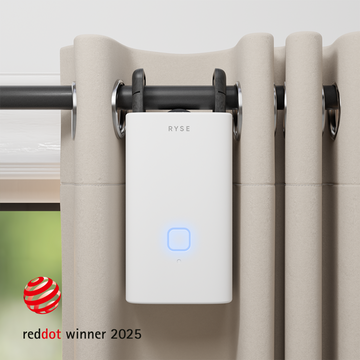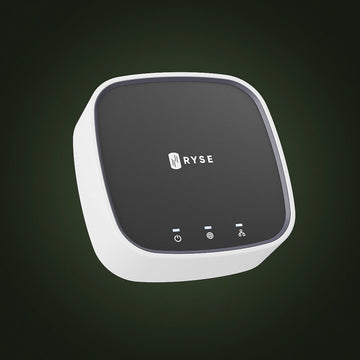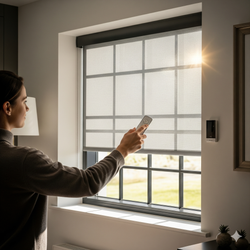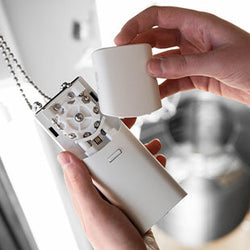Main Ideas:
- Your sleep environment plays a crucial role in sleep quality. Factors like light, noise, temperature, and air quality can significantly impact your rest.
- Motorizing blackout blinds can help block unwanted light and support a healthier sleep cycle without a hassle.
- Maintaining a comfortable temperature, reducing noise, and using the right mattress and pillows improve sleep quality.
- Consistency is key — following a nightly routine and adjusting your bedroom setup to your needs can make falling asleep easier.
- Small changes, like automating your blinds to adjust light exposure naturally, can make a big difference in sleep quality.
Falling asleep on time is only part of the equation — your sleep environment matters just as much. If you often toss and turn or wake up at night, your bedroom setup might be working against you without you even realizing it.
In this guide, we’ll walk you through the essential elements of an ideal sleep environment and how small adjustments, like controlling light exposure with automated blinds, can make a significant impact.
Learn more How Lack of Sleep Affects Your Brain, Body, and Emotions.
What Makes a Sleep Environment Ideal?
A sleep-friendly environment is one that minimizes disturbances and supports your body’s natural sleep-wake cycle. Here’s what you need to focus on:
- Light Control
Light is one of the most important factors affecting sleep. Exposure to artificial light at night can suppress melatonin production and disrupt your circadian rhythm. The best way to control light exposure is by using blackout curtains or smart blinds that adjust automatically with the time of day.
Tip: RYSE smart blinds can help you manage natural light effortlessly, ensuring your room stays dark when it’s time to sleep and gradually lets in morning light for a natural wake-up experience.
Discover how automated blinds can improve your sleep (link to a product, an article or a promotion)
2. Noise Reduction
Even subtle noises can interrupt sleep cycles. White noise machines, soundproofing, or soft background music can help mask disruptive sounds. Carpets, heavy curtains, and upholstered furniture also help absorb noise, making your room quieter.
3. Temperature Regulation
Your bedroom temperature should be cool—ideally between 16-19°C (60-67°F). Too much heat can lead to restless sleep, while extreme cold may cause discomfort. Consider breathable bedding materials and programmable thermostats for optimal temperature control.
4. Comfortable Bedding
Invest in a good-quality mattress and pillows that support your sleeping posture. Your body’s needs may change over time, so regularly assess your comfort level and upgrade when necessary.
5. Freshen Up the Air
The quality of the air in your bedroom can impact your sleep. Ensure proper ventilation, use an air purifier, or introduce calming scents like lavender or eucalyptus to create a soothing atmosphere that helps you unwind.
Shift work can disrupt your body’s natural rhythm — learn how to manage it effectively in Getting Quality Sleep While Working Shifts: Here’s How.
Small Changes That Improve Sleep Quality
Implementing small changes in your daily routine and bedroom setup can make a big difference in how well you sleep:
- Ditch all the devices an hour before bedtime to lower the blue-light exposure
- Dim the lights half an hour before bed to signal your body that it’s time to wind down.
- Automate your window treatments to adjust with the sunrise and sunset for a natural sleep-wake cycle.
- Avoid eating and drinking two hours before bed to fall asleep easily and wake up more rested
- Follow a consistent bedtime routine to train your body to recognize when it’s time to rest.
Find out how RYSE motorized blinds can enhance your sleep environment (link to a product, an article, or a promotion)
Related Blog 1: Sleep Disrupted: How Alcohol Impairs Your Rest and How to Fix It
Related Blog 1: Rain Sounds, White Noise, and Sleep: What Actually Works?
Elevate Your Sleep with Simple Adjustments
Creating the perfect sleep environment doesn’t require drastic changes — sometimes, the smallest adjustments can lead to the most significant improvements. You can create a space that promotes restful sleep by controlling light, managing noise, maintaining the right temperature, and improving the air quality. All these small bits will help you make healthy sleep your new habit.
RYSE SmartShades are just one example of how smart home technology can enhance your bedroom setup. By automating light exposure, you ensure your room stays dark when you need rest to promote melatonin production and add a controlled amount of light to wake you up without stress.
Incorporating these thoughtful adjustments can transform your sleep environment into a sanctuary for rest, ensuring that you wake up refreshed and energized every day. Start with one or two changes today, and see the difference it can make in your sleep quality.
To learn the truth behind common misconceptions about teen rest, read Teen Sleep Myths and Facts: How Much Sleep Is Ideal for Teens?







